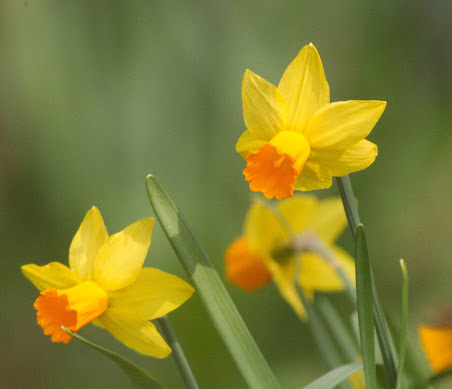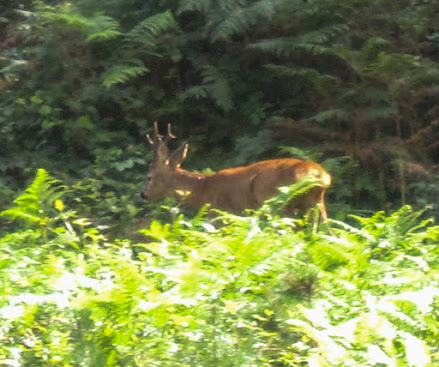A to Z challenge 2023 – D is for . . .
My
theme for this challenge is Nature in all much of her wonderful
diversity. My posts will reflect the fact that I am resident in the south of
England.
All
photographs in this post are the property of the writer
Daffodils
The Latin
name for daffodil is Narcissus. Narcissus was a beautiful young man. When he
caught sight of his reflection in a pool of water, he became so bewitched by
his own beauty that he fell in love with his image. He could not tear his
gaze away and faded away into death. He was then turned into a flower, the
daffodil we know today in its many forms.
The
daffodil is one of the first perennials to flower in Spring and as such is a symbol
of rebirth and hope. Daffodils were introduced to England by the Romans who
thought that the sap had healing powers.
In
England, it is known as the Lent or Lenten lily, because it blooms between Ash
Wednesday and Easter. It is also the symbol of the Marie Curie cancer charity
and is worn throughout March as a sign of support.
D is also
for Dunnock (Prunella modularis)
Dunnocks
are small, unobtrusive grey and brown birds. The name dunnock comes from the English
‘dun’ meaning dingy brown or dark-coloured and ‘ock’ meaning small.

They eat
insects, spiders, worms and some seeds.
Dunnocks can copulate more than 100 times a day. The female dunnock will mate with several males, meaning that chicks within the same brood may have different fathers. Sometimes two males she has mated with will work together to protect a territory against rivals and help her to raise her young.
Chicks may be raised by a single female, or by many females with the help of a male, or by many females and males together. Although males are not thought to discriminate between the chicks in a brood, they invest more time in feeding the young if they have had access to the female and may therefore have impregnated her.Their nests
are built low down in a bush or conifer and are constructed of twigs and moss
and lined with feathers or other soft material. The eggs, laid in clutches of
three to five, are blue.
The nests
are often targeted by cuckoos.
Although
they appear quite plain, a closer inspection reveals intricate feather
patterns. It is always a pleasure to see these little birds at home in my
garden.
My final
D is for Deer.
The deer in our local woodlands are Roe deer (Capreolus capreolus). They are one of the two truly native deer of the British Isles, though they are not found in Ireland. The other native deer are the red deer.
‘Bambi’, Felix
Salten’s book (1928), was originally about the life of a roe deer.
Roe deer are about 75 cm tall at the shoulder and weigh up to 25 kg. Their natural lifespan in the wild averages 10 years.
Their coat colour varies from rusty red in the summer to slate grey in the winter and both doe and buck have a white rump. The doe’s white rump is heart-shaped and the buck’s is shaped like a kidney.
Young buck
Roebucks have
three-pointed antlers when they are fully adult and unlike other deer, begin to
regrow them almost immediately after shedding them. Their main diet is grass,
leaves, berries and the shoots of young trees.
The breeding
season or ‘rut’ is from mid-July to August, when bucks battle for the right to
mate with a receptive doe. Roe deer delay the implantation of a fertilised egg
until January to avoid giving birth in harsh winter conditions when food is
scarce, so although gestation is 9 months, the first four months see no growth
followed by five months of developing embryo. The does give birth to two or
three kids in May or June, but many perish shortly after birth, often due to
predation, or during the cold of their first winter.
The best
times to see them are around dawn and dusk when they are feeding. Daytime is
spent hidden from view, ruminating.
Most ruminants have stomachs with four chambers. These allow the animals to digest food without completely chewing it first. Some is brought back up to be chewed again and this is called chewing the cud, commonly observed in cattle.



















Great post. I especially enjoyed the part about the dunnock, and learned a lot. Copulating up to a hundred times a day - who knew? What stamina!
ReplyDeleteCheers, Gail.
Thank you:-)
ReplyDeleteI don't think they practise tantric sex - no time!
I hadn't realised that the humble dunnock was so promiscuous! We don't see them here as much as in our previous garden. We had a lot of LBJs there ("little brown jobs").
ReplyDeleteThe secret life of birds, eh?
DeleteThe flowers are so pretty! Great photos.
ReplyDeleteRonel visiting for D:
My Languishing TBR: D
Dichotomy of the Sasabonsam
Thank you, Ronel.
DeleteF thinks if she had seen a dunnock she would have assumed it was a sparrow. Sparrows were introduced to NZ so she was familiar with them, but not so the dunnocks.
ReplyDeleteI think at one time in our UK natural history all small birds were called sparrows, but I can't track down any references. Shakespeare comes to mind . . . as ever . . .
DeleteFascinating info about the Dunnock, we frequently have these lovely little birds at our feeder and you've taught me all about them today TQ
ReplyDeleteAlison in Wales x
I love them. They're so unassuming.
DeleteI never knew the Latin word for daffodils. Mine are just starting to come up. It was a cold March in Michigan.
ReplyDeleteThe flowering season for daffodils can be quite long, sometimes. Thank goodness spring has arrived for you at last :-)
ReplyDeleteAnother post full of interest!
ReplyDeleteI find Daffodils irresistible, and I'm loving the symbolism attached to them. Their common name here in Belgium is very close to their Latin name: Narcissen.
We used to have Dunnocks (which are called Heggemus, transl. Hedge Sparrow, here) flock to our garden, but I haven't seen any lately. I had no idea they are so promiscuous! xxx
How little we know of how others live, even quiet little brown birds!
DeleteLove this educational post about natural things. I wondered what the life-span of deer was. Thanks for all the info!
ReplyDeleteThank you. I gather deer can live for 20 years, but that would be in captivity, which isn't the natural span.
DeleteThis comment has been removed by the author.
ReplyDeleteMy daffs are just finishing up now, and the tulips are ready to open. Very soon the bluebells will be blooming! Your posts are great fun to read.
ReplyDeleteThank you, Misky. I do try (can be quite trying)
DeleteGiving a daffodil was once considered bad luck? Silly people! The daffodil is one of the rare flowers that is perfectly shaped and coloured.
ReplyDeleteOne wonders how such superstitions arise . . .
DeleteG'day Janice,
ReplyDeleteIt is those little brown birds that fly under our radar in Australia as we have so many that are bright and colourful. In general, it is the male that has bright plumage which is needed to attract the females. Here is a post about fairy wrens in Australia. https://www.australiangeographic.com.au/topics/wildlife/2019/03/a-guide-to-australias-fairy-wrens/
What glorious little birds. Thank you for the link.
DeleteDaffodils are one of my favorite flowers. Where I live, they bloom in early March and are followed in April by tulips. The transition of the flower fields is a lively harbinger of spring. :)
ReplyDeleteIt's busy and gets busier . . .
DeleteI had never heard of the Dunnock and if I saw one I would assume "sparrow". But now I know better, also Dunnocks aren't found in Australia I believe?
ReplyDeleteNo, no dunnocks in Australia, but you have so many beautiful, bright birds that a dunnock would go unnoticed, I think.
ReplyDelete"Their main diet is grass, leaves, berries and the shoots of young trees.", and plants in country domestic gardens I believe.
ReplyDeleteYes, those too ;-)
ReplyDeleteWe had the best year for daffodils that I remember this year. We get deer in our yard, too. In Missouri we have white-tailed deer and they are voracious in gardens, but fortunately don't like daffodils!
ReplyDeleteI know deer can be a dreadful nuisance in gardens but they are just so beautiful.
Delete